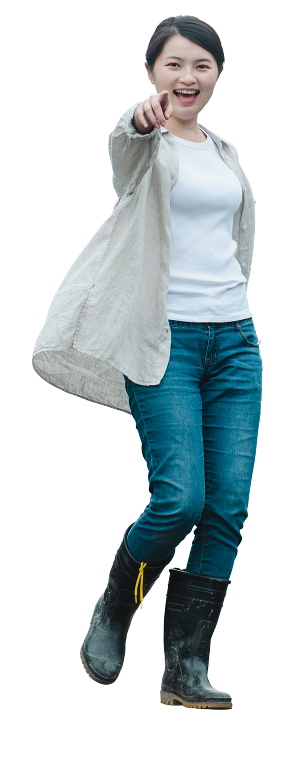How does it feel to open the kiln and see your own work?
 The color is nothing like the soil! The soil we collected was dark grey, but after firing, it turned pink-orange, feels like switching from the cold color palette to the warm. When I held the burning hot pottery in my hand, I thought to myself, this took me two whole days. In this day and age when mass-produced pottery is a dime in the dozen, it cannot be easy for the pottery-making skills to be passed on in today’s world. But I can relate to why the elders used to cherish what they had in the old days, these things just cannot be bought with money.
The color is nothing like the soil! The soil we collected was dark grey, but after firing, it turned pink-orange, feels like switching from the cold color palette to the warm. When I held the burning hot pottery in my hand, I thought to myself, this took me two whole days. In this day and age when mass-produced pottery is a dime in the dozen, it cannot be easy for the pottery-making skills to be passed on in today’s world. But I can relate to why the elders used to cherish what they had in the old days, these things just cannot be bought with money.
How did you feel going wild vegetable gathering for the first time?
 The first time that I heard the elephant grass core is a wild vegetable was when Afo’ picked it from their field. As Afo’ said, you get to experience how a cow feels chewing on hay. The Elephant grass core is very juicy and really quenches the thirst. Then it’s the peeling of the palm, it really was hard! That was my first time peeling anything with a sickle, and I swung miss all the time, so embarrassing. The toughest part of all is that every dongec has different levels of maturity, and different levels of strength are required. The younger dongec is softer and comparatively easier to peel, but it still takes a lot of strength. I only peeled three and I was already sweating profusely. I can imagine just how strong Afo’ and the others are. Returning to the studio to peel the dongec, revealing the white dongec inside, and then breaking them into pieces with the bare hands was actually a rather elegant process. The dongec is one that is fierce on the outside but soft on the inside. I will try gathering dongec when I return to my own indigenous community.
The first time that I heard the elephant grass core is a wild vegetable was when Afo’ picked it from their field. As Afo’ said, you get to experience how a cow feels chewing on hay. The Elephant grass core is very juicy and really quenches the thirst. Then it’s the peeling of the palm, it really was hard! That was my first time peeling anything with a sickle, and I swung miss all the time, so embarrassing. The toughest part of all is that every dongec has different levels of maturity, and different levels of strength are required. The younger dongec is softer and comparatively easier to peel, but it still takes a lot of strength. I only peeled three and I was already sweating profusely. I can imagine just how strong Afo’ and the others are. Returning to the studio to peel the dongec, revealing the white dongec inside, and then breaking them into pieces with the bare hands was actually a rather elegant process. The dongec is one that is fierce on the outside but soft on the inside. I will try gathering dongec when I return to my own indigenous community.
What do you think making pottery means to the culture after the past three days?
 Many of my friends think that there must be a reason why these things were forgotten in time, either because they are not convenient enough or that their existence is no longer required in the present age. But then why make pottery? Many people asks why not just use glass or plastic cups? I believe that the main difference lies in the patterns on the ritual cup and pot. The patterns carry the stories of the people. If we replaced it with a glass cup and lose the stories carried by the patterns, the spirits of the people will disappear as well. For example, we learned that harmony and mother’s love are symbols of cultural essence, philosophy of life, and values. Pottery is valuable not just as a utensil but also in its inherent culture. Indigenous peoples had no written language, how did we record our stories? Most of the time via patterns, patterns that convey plenty of messages.
Many of my friends think that there must be a reason why these things were forgotten in time, either because they are not convenient enough or that their existence is no longer required in the present age. But then why make pottery? Many people asks why not just use glass or plastic cups? I believe that the main difference lies in the patterns on the ritual cup and pot. The patterns carry the stories of the people. If we replaced it with a glass cup and lose the stories carried by the patterns, the spirits of the people will disappear as well. For example, we learned that harmony and mother’s love are symbols of cultural essence, philosophy of life, and values. Pottery is valuable not just as a utensil but also in its inherent culture. Indigenous peoples had no written language, how did we record our stories? Most of the time via patterns, patterns that convey plenty of messages.
What would you like to say to the three teachers?
 Thank you for everything in the past three days. I made a small atomo this time, and at the end, ina said, “I hope Afo’ is in there.” To me, that could mean so many things. I wonder if that meant her soul is in there, or the skills she taught me are in there, or that I am in there. Ina performed the Pangcah process of naming for me yesterday, not an official one, but I was very blessed. I see it as an encouragement for my own beginning. I hope that I can share the wisdom I have received here with the elders and youth of the SaySiyat, and that when I discover something new or gain wisdom in my own indigenous community, I will come back and share it with them. I hope that this is a beginning with roads to lead to the future.
Thank you for everything in the past three days. I made a small atomo this time, and at the end, ina said, “I hope Afo’ is in there.” To me, that could mean so many things. I wonder if that meant her soul is in there, or the skills she taught me are in there, or that I am in there. Ina performed the Pangcah process of naming for me yesterday, not an official one, but I was very blessed. I see it as an encouragement for my own beginning. I hope that I can share the wisdom I have received here with the elders and youth of the SaySiyat, and that when I discover something new or gain wisdom in my own indigenous community, I will come back and share it with them. I hope that this is a beginning with roads to lead to the future.
 I watched the teacher shape her clay while I adjusted the small clay pot I held in my hands, and most of the time, the teacher would keep reminding me, “shape slowly and go lightly, not too fast, feel with your hands, feel the thickness of the clay.” The clay pot or the piece of clay in my hand can only be experienced by my hands, feel its thickness, moisture, and stiffness, that’s how we can handle it. During the process, we kept “smoothing over the wound”, smoothing over the cracks on the clay pot. We were naturally nervous when we saw cracks, but the teacher simply said that cracks were inevitable, that clay can crack easily crack due to stretching and loss of moisture, “just smooth it over, don’t worry about it.” Her words are always a boost to the heart. Shaping clay may seem like a process of repeated smoothing, stretching, converging, and firming, and psychologically, it’s like when we face difficulties in life, we should just face them and deal with them. When clay is firmly and solidly shaped, our minds have also reached a balance and completion. It is an extremely comforting process. I believe that Afo’ finds great comfort in life while learning about traditional cultures or simply during the process of creating.
I watched the teacher shape her clay while I adjusted the small clay pot I held in my hands, and most of the time, the teacher would keep reminding me, “shape slowly and go lightly, not too fast, feel with your hands, feel the thickness of the clay.” The clay pot or the piece of clay in my hand can only be experienced by my hands, feel its thickness, moisture, and stiffness, that’s how we can handle it. During the process, we kept “smoothing over the wound”, smoothing over the cracks on the clay pot. We were naturally nervous when we saw cracks, but the teacher simply said that cracks were inevitable, that clay can crack easily crack due to stretching and loss of moisture, “just smooth it over, don’t worry about it.” Her words are always a boost to the heart. Shaping clay may seem like a process of repeated smoothing, stretching, converging, and firming, and psychologically, it’s like when we face difficulties in life, we should just face them and deal with them. When clay is firmly and solidly shaped, our minds have also reached a balance and completion. It is an extremely comforting process. I believe that Afo’ finds great comfort in life while learning about traditional cultures or simply during the process of creating.
In this journey, I see different peoples facing the same issues. Be it the SaySiyat or the Pangcah, we are all facing problems of the youth leaving indigenous communities, unwilling to learn traditional skills, or even feeling indifferent about traditional cultures. I asked my teachers while making pottery, whether they are worried that the skills they finally recovered may again face a gap in inheritance, and they nodded gravely. When looking broadly at the issue of passing on indigenous cultures, we can’t help but wonder where are the youth? Why will they not learn about their own traditional cultures? Is passing on cultures really dependent on outside resources? How necessary is cultural revitalization? These are the questions I asked myself on my way home. We face the same issues regardless of our ethnicity. I hope that by learning across ethnicities, I can observe how others solve problems and reflect accordingly.
My main takeaway this time is “sharing”. In addition to learning how to make Pangcah Pottery, I have also gained better insight into the historical context and cultural knowledge behind such skills, via the oral history provided by the teachers. The teachers were very gracious in saying that I can “share what you have learned today with your people, try to apply it to the clay in your own community and we can learn from one another.” Having been with them for the past three days, I saw their perseverance and patience for their culture and their tenacity and courage toward life. Filled with emotions and energy, I return home feeling grateful for this encounter, ma’alo’.
2022.06.07





